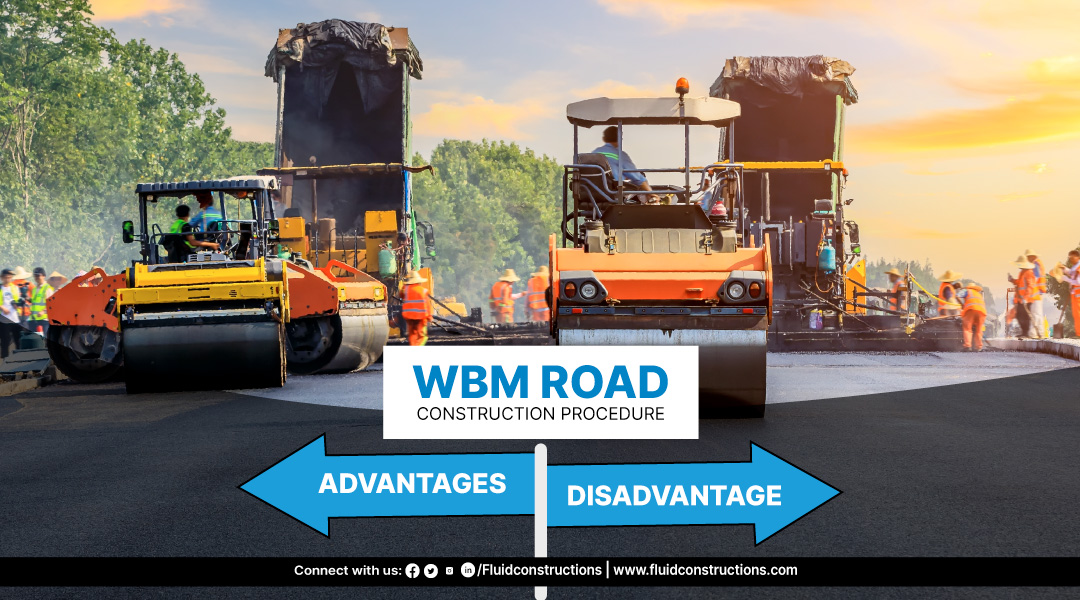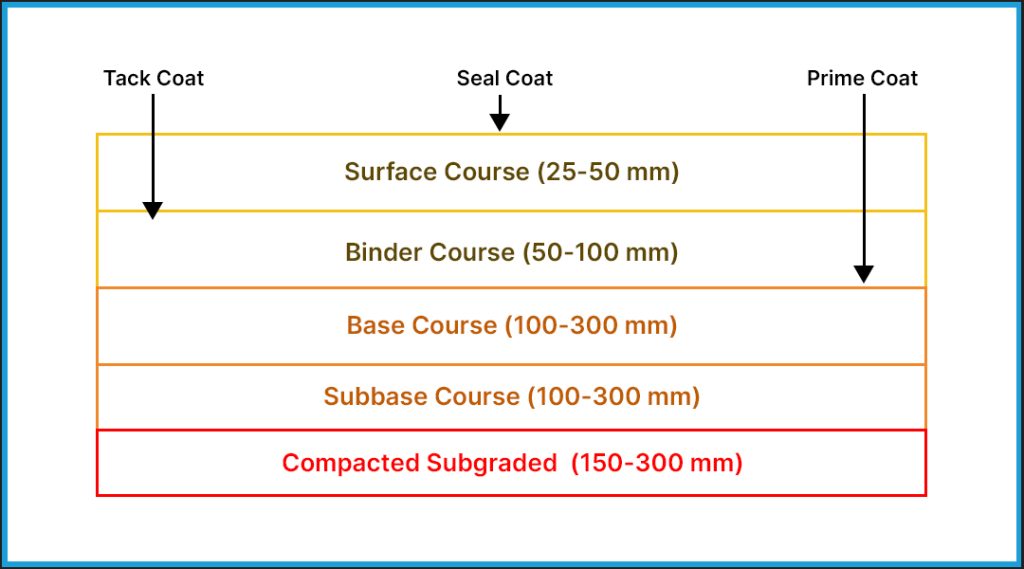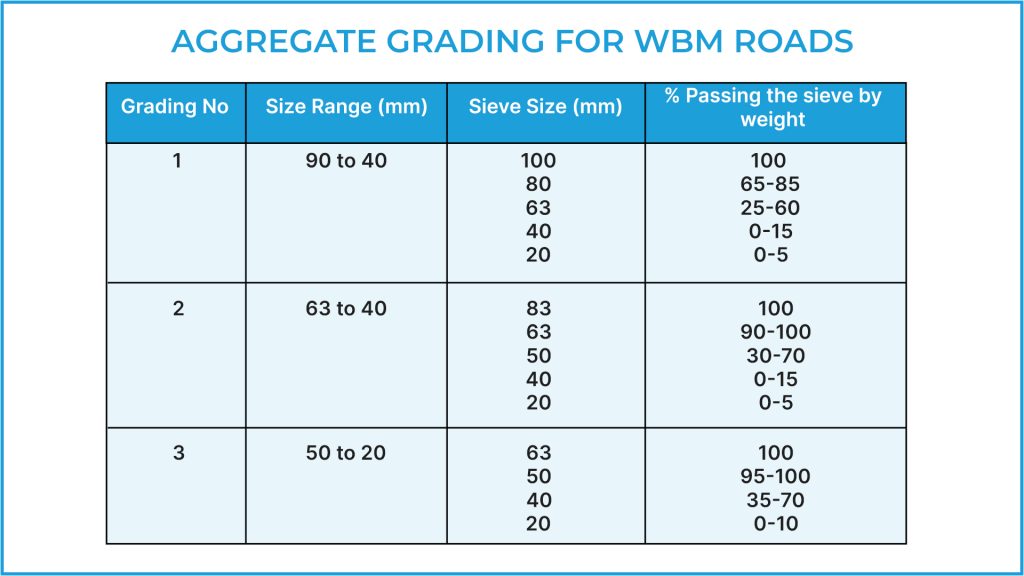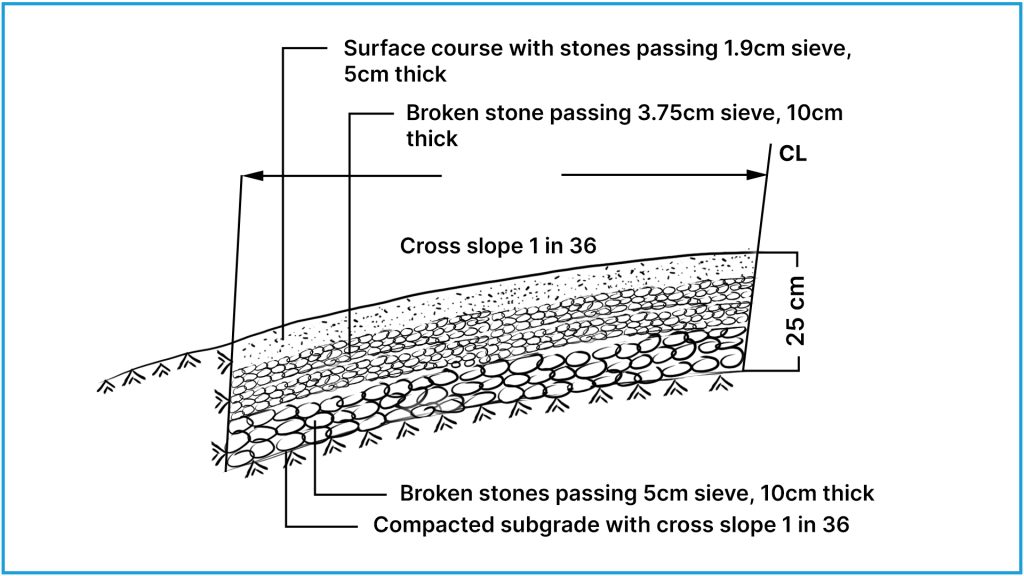
WBM Roads | Construction Procedure, Advantages and Disadvantages
The two major considerations behind choosing a road construction method are the expected traffic load and the allocated budget. That explains why most of the local roads in rural and even urban areas in India are WBM roads (with thin white topping nowadays).
Due to their use of unskilled labor and locally available materials, WBM roads present a low-cost yet viable solution for roads that do not have to carry heavy traffic in general. However, longevity depends on maintenance from time to time.
What is a WBM Road?
A WBM (Water Bound Macadam) road, named after Scottish engineer John McAdam, is a type of road construction method where multiple layers of crushed stone aggregates are compacted and bound together with water, but also with cement and bitumen.
What are the Different WBM Road Layers?
A WBM road has three layers – a bedding layer, a base or foundation layer, and a surface layer. The base and surface layers are composed of crushed stone or shattered rock fragments, which are further crushed and interlocked using a road roller. Screening materials (stone dust mixed with water) and binding materials (cement, bitumen), as well as water and compaction, are subsequently used to fill the voids.

Materials used in WBM Road Construction
Various materials are employed during the construction process to boost the road’s resilience and longevity. The materials utilized in the WBM road construction process are determined by road circumstances such as weather, topography, and the availability of local supplies. The three materials listed below are used in the construction of WBM roads.
- Coarse Aggregate
- Screenings (Filler Material)
- Binding Material

Coarse aggregate materials are made up of a combination of firm, durable crushed aggregates and fractured stones. Each layer of the WBM road construction should have appropriately graded aggregates.
Screening material is simply aggregates that are smaller in size than coarse aggregates. This is used to fill any remaining spaces in the compacted layer of coarse aggregate.
The binding material used in WBM road construction consists of stone dust, cement, and bitumen. However, the use of binding material may not be required if screening is done properly.

WBM Road Construction Procedure
1) Preparation of foundation or sub-grade:
The subgrade or foundation course is adequately constructed for the required grade and camber of the WBM road. Potholes and depressions in the road’s surface are appropriately filled and compacted.
2) Preparation of sub-base:
Before installing aggregates, shoulders with the same thickness as the compacted WBM layer should be built to provide lateral confinement provision of aggregates. They should be built using high-quality murram or earth.
The major goal of building shoulders is to keep the road surface built in place and make the future laying of coarse aggregates easier.
3) Spreading of coarse aggregates:
Following the construction of the shoulders, the coarse aggregates are uniformly dispersed on the prepared base. The total number of layers and thickness of WBM road are determined by the design details of the pavement.
In general, a single layer of compacted thickness of 7.5 cm may be sufficient for regular roads. Two layers, i.e. 15 cm compacted thickness each, may be used for specific roads. If the coarse aggregate of grade 1 is used, it is compacted to a thickness of 10 cm.
4) Rolling operation:
This operation is used to condense the coarse aggregates. It is usually done with the use of three-wheeled power rollers weighing 6-10 tonnes or vibratory rollers.
Skilled operators should be used to drive the rollers because incorrect rolling operations produce corrugations, uneven road surface finish, and road wear in the first few months of construction.
5) Application of screening materials:
After the rolling process is completed, screenings are used to adequately fill the voids left after aggregate compaction. Depending on the site conditions, the screening may be applied in three or more layers.
After uniformly dispersing the screening, compaction is done with dry rollers for each layer of screening. After compaction, each layer should be adequately broomed to eliminate any uncompacted screening material.
6) Water sprinkling and grouting:
Following the application of screening, the road surface is thoroughly watered. After the water is sprinkled, brooming is performed to correctly sweep the wet screening into the voids.
A rolling operation is then performed to ensure optimum compaction. If the spaces remain apparent, additional screens can be put in and compacted properly.
7) Applying binding material:
The same technique as for screening material is followed for binding material application. After each layer, water is sprinkled and a rolling operation is performed.
During the rolling operation, the roller wheels should be constantly moistened to wash out the binding material that becomes adhered to the roller wheels.
8) Surface setting and drying:
Following the last rolling process, the road is ready to cure or set overnight. If the depressions or voids are still evident the next day, a sufficient amount of screens or binding materials can be applied and compaction can be completed.
9) Building of shoulders:
Shoulders are built alongside the road during the curing process by filling the specified cross slope with earth and then compressing thoroughly.
10) Open for traffic:
Finally, the road is opened for traffic after it has dried properly and is free of depressions. For a few days, traffic should be evenly divided across the entire width of the road by placing roadblock equipment like drums, barricades, and so on.
Advantages and Disadvantages of WBM roads
Advantages:
- The cost of building a WBM road is relatively inexpensive.
- In the construction of WBM road, no expert laborers are required.
- They are made of locally available materials.
- If the WBM roads are properly maintained and checked on a regular basis, they can withstand traffic loads of up to 900 tonnes per lane per day.
Disadvantages:
- Regular maintenance of the WBM roads is a must.
- Water seepage into the subsoil damages the road during the rainy season.
- Not recommended for high-speed vehicles.
- Not recommended for heavy vehicles.
It’s not uncommon to find a newly constructed road has gotten damaged. While it may be due to substandard materials and procedures used by the contractor, the other more obvious chances are due to the movement of high-speed and heavy vehicles on the road. The WBM roads provide excellent solutions for the local roads, but they should be used within their limitations.
Maintenance of WBM Roads
1. Regular inspection and timely repair of potholes are crucial for maintaining WBM (Water Bound Macadam) roads.
2. Implement effective drainage systems to prevent water stagnation, which can weaken the road structure over time.
3. Regular cleaning of road shoulders and ditches helps in avoiding blockages and ensures proper water flow.
4. Apply appropriate grading materials to replenish the surface layer and maintain the road’s stability.
5. Periodic rolling and compaction of WBM layers enhance durability and reduce the risk of deformation.
6. Monitor and control vegetation growth along the road edges to prevent root damage to the road structure.
7. Conduct routine checks on road camber to ensure proper water runoff and prevent erosion.
8. Promptly repair any signs of wear, like rutting or corrugation, to prevent further deterioration.
9. Control vehicular overloading to minimise stress on the WBM structure and extend its lifespan.
10. Educate local communities on responsible road use and the importance of reporting maintenance issues promptly.
It’s not uncommon to find a newly constructed road has gotten damaged. While it may be due to substandard materials and procedures used by the contractor, the other more obvious chances are due to the movement of high-speed and heavy vehicles on the road. The WBM roads provide excellent solutions for the local roads, but they should be used within their limitations.
FAQ’s
1. Is the WBM road a metalled road?
– No, a WBM (Water Bound Macadam) road is not considered a metalled road. It is a type of road construction method where multiple layers of crushed stone aggregates are compacted and bound together with water, cement, and bitumen.
2. What materials are used for WBM road construction?
– The materials used in WBM road construction include:
– Coarse Aggregate: Firm, durable crushed aggregates and fractured stones.
– Screening Material: Aggregates smaller in size than coarse aggregates, used to fill voids in compacted layers.
– Binding Material: Stone dust, cement, and bitumen, used to bind the aggregates together.
3. What is the full form of the WBM road?
– WBM stands for Water Bound Macadam.
4. What is screening material in WBM road construction?
– Screening material in WBM road construction refers to aggregates that are smaller in size than coarse aggregates. This material is used to fill any remaining spaces in the compacted layer of coarse aggregate, ensuring a solid road surface.
5. What is binding material in WBM road construction?
– Binding material in WBM road construction consists of stone dust, cement, and bitumen. It is used to bind the aggregates together, providing strength and stability to the road structure. However, the use of binding material may not be required if screening is done properly.
